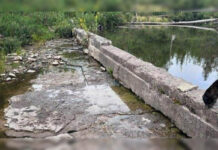Industry-initiated testing to improve water quality controls
WABUNO CHANNEL—A team of scientists from the federal Department of Fisheries and Oceans are conducting studies of the sediment and waters beneath local fish farm cage operations to find more efficient and practical ways to determine what, if any, impact those operations are having on the ecosystems in the vicinity of those operations.
“This is my project,” explained Blue Goose Aquaculture manager and aquaculture pioneer Mike Meeker, stressing that the project design and parameters far exceeds that required for the operating licence of the aquaculture operation. “We are seeking a way to simplify the testing we have to do.”
If successful, the project, which has been ongoing for the past two weeks and will continue for another two or three weeks, will not only provide better science on the impact the operations are having on the water and sediment beneath the fish farm operations but will assist in designing more efficient and accurate testing regimes. That goal has the potential to not only improve knowledge of what is going on beneath the waves, notes Mr. Meeker, but also to introduce better and more efficient and cost-effective testing that will benefit the industry. A win-win situation. “This isn’t regulatory,” he said. “It is research to try and to do a better job of the work we do and the dollars we spend on monitoring.”
Under the direction of Supervisor Cheryl Podemski, known affectionately as “the bug lady,” the team has been assisted in their work by Mr. Meeker, who is a trained commercial diver.
“I have been working with her for close to 20 years,” he said. Mr. Meeker had high praise for Ms. Podemski and the skill of her team. “They are one of the top groups of researchers,” said Mr. Meeker. “They are as good as anywhere in the world.”
Ms. Podemski earned her nickname for her expertise in the realm of phytoplankton and zooplankton (microscopic plants and animals) that live in the sediment on lake bottoms and has been leading a major study at the famed Freshwater Institute in Winnipeg, Manitoba and the Experimental Lakes Area, which holds 58 small lakes in a forested region of northwest Ontario.
The results of the testing at the Blue Goose fish farm sites, posits Mr. Meeker, will add considerably to the science and knowledge involving an agricultural industry that holds great potential for meeting the healthy nutritional needs of a world whose supplies of fish have been in a steady decline in the wild for several decades.
Mr. Meeker said that he held out little hope that the project and the science it discovers will have any impact on critics of the fish farming industry who have already made up their minds, but he said he did hope that it would suit to inform those who wish to learn more through the application of solid science.
“I believe it will make a difference to anyone who has an open mind and will look at the evidence,” he said. “Not only those who have the scientific training to analyse the data, there are lots of intelligent people who are not necessarily trained in science, but who can look at the knowledge gained and learn more about the facts unclouded by emotions. Those are the people I want to do this for, they may not understand the technical details, but it (the analysis of the data) can help inform them—not the crap that some people put out there.”
Mr. Meeker pointed out that both the commercial and sports fishery on the Great Lakes has been under severe strain in recent years from a near perfect storm of invasive species that have severely impacted the food supply of indigenous wild fish.
“Any ecosystem is a complex system and it is not just one issue that is causing the decline (in the wild fisheries),” he noted. He agreed that part of the challenge facing the fisheries may even be linked to the more positive practices in terrestrial farming and nutrient conscious landowners near water bodies. Thirty or 40 years ago fertilizer was cheap, now farmers are applying their fertilizers in a much more targeted manner and landowners beside waterways are not fertilizing their lawns the same way, he noted. “They are being far more conscious of the potential impact they may be having.”
“The result is that there are far fewer phosphates going into the water than back in the ‘60s when the Great Lakes were turning into pea soup,” he said. “Now there may not be enough.” This has been a consensus of the Great Lakes fisheries industries for some time, noted Mr. Meeker. “But the general public has not been made aware of that.”
Algae provides the food source for plankton and plankton form the core food source for fish in the wild. “Plankton is the key,” he said. “Every species in the Great Lakes needs that plankton.”
There does not seem to be any quick fix or solution to the phosphate conundrum or the decline of the fisheries, making farmed fish an increasingly important source of global nutritional needs.
Mr. Meeker’s project has the potential to help to make the fish farming industry more efficient in tracking and/or rectifying any potentially negative impact it might be having on the Great Lakes ecosystems while at the same time reducing the costs to producers—a win-win situation.





